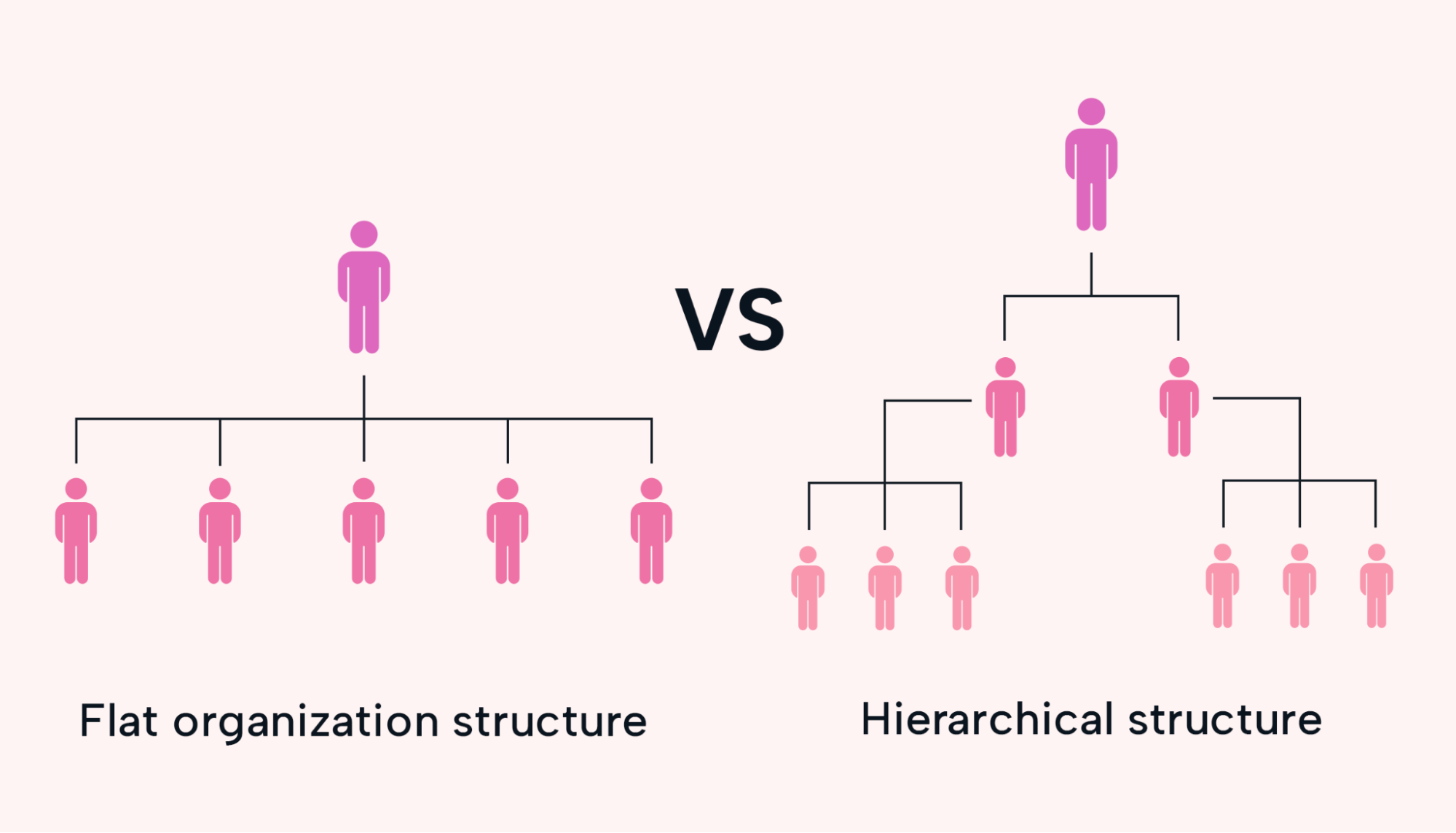tDo titles and designations matter less, and does the work matter more to you? Does the age-old, traditional corporate structure feel like a complex mess?
Then, you might be the right organization to adopt a flat organizational structure!
But what exactly is it? If you’re considering implementing it, then how should you go about it? Don’t worry. We have answers that’ll help you make a choice!
In this article, we’ll go over the flat organizational structure and its advantages and disadvantages. We’ll also cover some tips to implement the structure smoothly and address relevant FAQs.
What is a flat organizational structure?
A company with a flat organizational structure means there are few or no hierarchical levels between employees and leadership. This means all employees usually have the same authority.
Startups and small businesses most commonly adopt a flat organizational structure.
Why? Because they have smaller teams and often don’t need hierarchies for administration.
The lack of middle layers between the CEOs and the entry-level hires makes everyone in the organization more accountable. It also ensures that employees have authority and direct access to leaders.
Even some large companies value innovation and decision-making by all employees. This includes giants like Google and Hubspot!
How does a flat organizational structure work?
In a conventional hierarchical framework, employees are accountable to their respective first-line managers. These first-line managers report to middle managers. The middle managers then relay information to senior managers at the top of the organizational structure.
But it’s a little different for a flat organization.
Since there aren’t many levels of hierarchy, associates communicate directly with higher-level managers. This decentralizes the traditional middle manager (like eliminating the middleman) role by distributing it between the associates and higher-level managers.
What are the advantages of a flat organizational structure?
Here are some benefits of flattening your organization:
1. Reduced labor and operations expenses
The layer of middle managers is the most expensive because of their experience level and thus high salaries. But in a flat organization, these middle management roles don’t exist.
Result? You don’t need to make many hires, allowing you to save on:
- salaries
- costs associated with training and benefits
- operational expenses due to fewer employees
The good news? You can use these funds to support other areas, such as:
- employee training
- performance bonuses
- business growth and development
Or even office supplies your team has been wanting for a while.

2. Clear communication and easy collaboration
When information has to go through layers and layers of administration, it will degrade by the time it reaches its destination. You remember the childhood “telephone” game?
That is not the case with flat organizations!
In flatter organizations, information reaches its destination promptly or immediately as it needs to pass through fewer layers. This results in little to no degradation. So, goals and decisions are effectively communicated.
With effective team communication in place, easy collaboration isn’t far behind for a flat organization. Fewer hierarchy layers foster an environment where employees feel accountable for their work. Such a space enhances collaboration skills as they must report directly to leadership.
To optimize these collaborative endeavors, use project management solutions like Motion. Motion's AI task manager lets you assign tasks to your team members and view their progress. This brings in a sense of accountability and promotes transparency within an organization.

3. Increased responsibility and motivation
With middle management out of the picture, employees have greater responsibility than in a traditional organizational structure with multiple hierarchies.
As a result, employees feel more encouraged, cherished, and involved in the organization, which leads to increased productivity.
4. Easy talent spotting
Thanks to increased responsibility and accountability, spotting the most skilled employees is much easier.
What does this mean for you?
You can strategically place your top talents where they'll shine the brightest. In turn, your dream team will turn your workplace into a productivity playground.
5. Allows room for innovation and ideas
In a flat organizational structure, every employee has an equal voice — like a democracy. They can share new ideas and feedback on the following:
- operations,
- processes,
- products,
- services,
- business models,
- and company policies.
But that’s not all.
Innovative ideas need official approval nods. In a hierarchical or traditional structure, this would mean delays.
In a flatter structure, however, you can form and assign teams to a task or project ad hoc, without waiting for the leadership’s approval.
And guess what? Having a voice results in motivation and retention because employees feel valued!

What are the disadvantages of a flat organizational structure?
There sure are a few downsides to a flat structure, like:
1. Uncontrolled hierarchy formation
You can make an organization flat, but not your employees.
There’ll always be some natural leaders and strong decision-makers in your organization. And guess what? Over time, they can form unofficial management teams with their influence.
To protect your organization from unwanted hierarchy, promote transparency to keep a check.
2. Lack of career growth or promotion
The downside to having no hierarchy is that there’s nowhere to promote your employees. It makes it hard for employees to picture their growth and progress in your organization.
To combat this issue, you want to lay down some guidelines on how promotions work or introduce a recognition program.

3. Autonomy can overwhelm employees
Now this isn’t always the case. But it’s highly possible.
Employees with autonomy can be lost and overwhelmed. Yes, this can happen even to the most self-driven if they’re not adequately trained. They may not spot areas where their expertise is needed without an authoritative figure guiding them. This is particularly true for new hires.
4. It can create a lack of work-life balance
In a flat organization, employees usually have access to or report directly to the C-suite. We already know that and it’s great for employee responsibility and accountability.
But it can become an imposition. For example, employees can’t avoid emails or urgent tasks from higher-ups, attacking their sacred me-time. This hampers employees’ work-life balance.
But how do you curb these issues?
How do you implement a flat organizational structure?
Considering flattening your organization? Here are some tips for you:
1. Set clear expectations and define roles
According to a recent survey, 40% of respondents said unclear roles and responsibilities cause inefficiencies. This means inefficiency is one of the biggest flat organization threats. The lack of hierarchy in a flat organization can result in unclear roles and responsibilities simply because there’s so much autonomy.
So, how do you become the hero of organizational clarity? Lay down the law!
By that we mean, setting clear expectations and defining roles for each employee, ensuring that they align with the goals and objectives of your organization. Then provide employees with valuable guidance to confidently carry out their job. You can do so by providing training that makes employees feel supported.

2. Create growth opportunities for employees
A Pew Research Center survey shows that 63% of people found the lack of advancement opportunities as the main reason for quitting their jobs.
That’s bad news for flat organizations, as they can limit opportunities for employee advancement within the company. This is a big no-no for employee morale.
Career growth is a topmost priority for many individuals to be productive or continue working in your organization. That’s why it’s necessary to devise mechanisms that enable their career growth. But do make sure they adhere to this organizational structure.
Read more: How to calculate employee turnover.
3. Provide employees with access to resources
Since employees are required to be independent and make important decisions themselves in a flat organization, you need to provide them with the ultimate survival kit — the right resources. Only then can they effectively carry out their job.
Set clear policies, procedures, and processes to ensure your employees thrive in autonomy. This way they know what your organization expects from them.
4. Secure leaders’ validation and commitment
This one is super important. Ensure your top leaders agree and confirm they're okay with flattening your structure.
Why? Because their job titles will change and so will their responsibilities. They need to consent to that. They should also be willing to trust their employees to work independently, without constant supervision.
FAQs on organizational structures
Here are some FAQs relevant to organizational structures:
1. What are the different types of organizational structures other than flat?
There are seven other organizational structures:
- Matrix structure: Teams report to multiple leaders and support open team and cross-functional communication.
- Network structure: Cultivates collaboration by creating small, multidisciplinary teams. The organization doesn’t rely on a traditional hierarchy structure in this model.
- Team structure: Organizes employees into dynamic teams like Scrum or Tiger teams. This team-based structure prioritizes problem-solving and collaboration. It also empowers employees with greater autonomy and control over their work.
- Hierarchical structure: Pyramid-shaped organizational structure. The chain of command goes from the top (CEO) down (entry- and associate-level employees). Each employee has a manager. And most of the time, each manager has a manager … and so on.
- Functional structure: Similar to a hierarchical organizational structure. A functional organizational structure starts with higher-up positions and goes down from there. Here employees are organized based on their skills and functions in the company. Each department is managed independently.
- Divisional structure: The different company divisions control their resources and decisions. Each division can have its own marketing, sales, and IT teams. This can be based on groups of major products, or geography, or both.
- Projectized structure: In this structure, project management rules, because most of what the organization does is projects. In a projectized organization, there is much focus on developing project, program and portfolio management capabilities, and resources are assigned to semi-permanent specialized project teams.
2. What is a flatarchy organizational structure?
As the name suggests, a flatarchy is a hybrid of hierarchical and flat organization. Here you follow a hierarchy. But you can have flatter teams for specific projects or departments.
3. What is the difference between a flat and hierarchical organizational structure?
A flat organizational structure has few to no middle management levels between leadership and employees. All employees have access to the C-suite.
On the other hand, a hierarchical organizational structure is like a pyramid with a vertical chain of command. Here, the CEO is at the top, followed by multiple layers of management underneath.

4. Is Google a flat organization?
Google has some big shots in managerial roles. For a long time, the organizational structure was relatively flat, way back in the early 2000s. Its tech-oriented founders thought managers got in the way.
But growth has forced it to reconsider and become a cross-functional and team-based organization – basically a matrix. Each team member though has measurable OKRs (objectives and key results). Guess you can’t run a flat organization with close to 150,000 employees.
Ready to flatten your organization?
The flat organizational structure represents a dynamic shift in how we think about work and collaboration. This approach fosters open communication, encourages autonomy, and empowers employees at all levels. Not to forget, it’s a hotbed for innovation.
Additionally, it promotes a sense of ownership and responsibility, increasing organizational efficiency and agility.
But don’t forget to weigh the pros and cons before flattening your organization.
Lastly, consider using Motion’s AI-driven intelligent Project Manager to help you further optimize your flat organization structure. It helps visualize each team member’s tasks, roles, and progress — nipping micromanagement in the bud. Try Motion today for free for 7 days.




